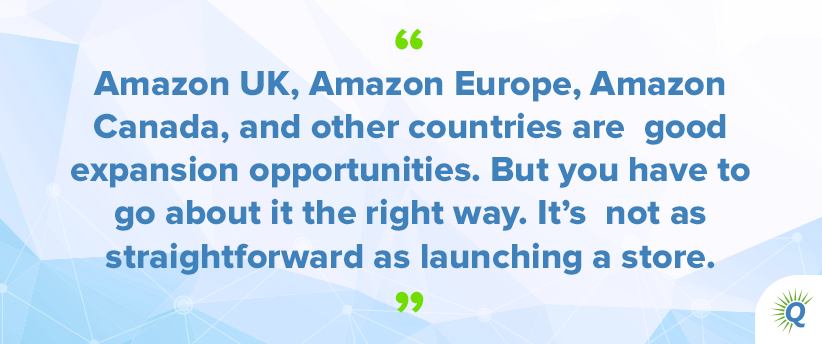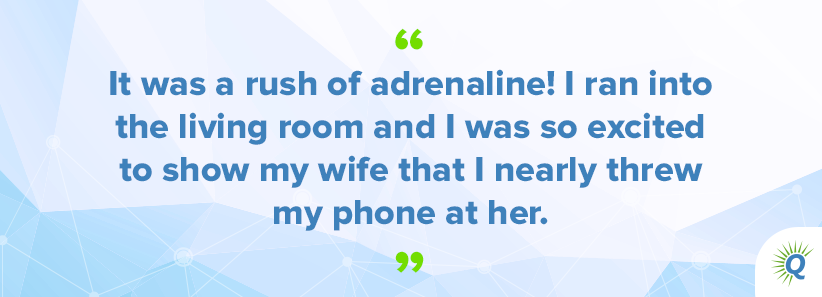Topics:
Never Miss a Beat - Get Updates Direct to Your Inbox
FILTER:


Build your Amazon business like Napoleon
By Quiet Light
Amazon is home to the digital gold rush. But are you growing a little stir-crazy digging for gold in one place? Great! It’s time to take your business into a new Amazon market. Steal Maximizing eCommerce CEO Kevin Sanderson’s blueprint for safely and productively selling on Amazon international.
Maximizing eCommerce, minimizing the BS
Taking eCommerce international
Is going international actually worth it, though?
A better way to expand internationally
Research before you do anything
Deliver kickass customer service, no matter what
Napoleon was just one dude, but he was known for conquering countries large and small. He had a knack for international expansion and reaped the benefits.
Of course, that pesky battle at Waterloo ended Napoleon’s stranglehold on the world.
Come to think of it, entrepreneurship is a little like world domination.
You know expansion is the key to success, but one wrong step will send your kingdom tumbling.
Quiet Light works with plenty of entrepreneurs who want to try selling on Amazon international, but like our beloved megalomaniac Napoleon, find it’s too much to take on successfully.
It happens pretty often: a seller has revenue lines on their P&L here and there for Amazon UK or Amazon Europe.
What happens is that sellers try to claim a stake in international markets, realize it’s mega-difficult, and back down.


The result is wasted time and a deflated ego.
But the problem isn’t that you expanded internationally.
The problem is that you likely didn’t have experience or a strategy for going international.
That doesn’t mean you should write off international expansion.
Actually, planting your flag across the globe can net you more sales than the US market.


Listen to the Source of this Post:
This blog post is based on a podcast episode that we recently recorded. Listen to the full episode here:Canada, the UK, Europe, and other Amazon marketplaces are perfect expansion opportunities, but you have to expand the right way.
If you don’t want to meet your Waterloo, you’ll need a plan.
Quiet Light sat down with pro Amazon seller, Kevin Sanderson, to chat about his strategy for selling on Amazon international.
Follow his tips to get your brand into other Amazon markets—without waving the white flag.
Maximizing eCommerce, minimizing the BS
Today Kevin Sanderson is the CEO of Maximizing eCommerce.
But like most entrepreneurs, he had no intention of becoming an eCommerce reseller.


(I mean, no kids say, “I want to sell on Amazon when I grow up.”)
Kevin was originally working as a high school football official.
He was listening to a podcast “Amazon Seller” that stopped him in his tracks. He was intrigued and gave it a listen.
From that moment on, Kevin was hooked on the idea of making a living on Amazon.
In a classic example of resale arbitrage, he swung by Walgreens and stocked up on, in his words, “those blue cooler things” during a huge back to school special.
“I went to Walgreens and they were closing out the summer specials. I bought a bunch of those blue cooler thingies that you use to keep your cans cool in the summer.”
Kevin sent the coozies off to his Amazon seller account just to see what would happen.
His first sale came in soon and he was addicted to the adrenaline of making a sale.
In hindsight, Kevin admits resale arbitrage isn’t the most efficient business model, but it was a great way for him to learn.
From then on, Kevin put all of his efforts into building his Amazon business. He took a year’s worth of earnings from his full-time job to build his first real product.


After creating a branded product in February 2016, Kevin continued reinvesting in the business—and his work paid off.
He quit his job as a coach in December 2018 to do eCommerce full-time.
Taking eCommerce international
Kevin’s addicted to growth.
He knows that every kickass business has an equally kickass expansion strategy.
Kevin’s plan for selling on Amazon international (which I’ll share in a sec) has paid off big time.
Today he sells 80 products in Canada, all five European Amazon marketplaces, and Japan.
Oh, and if that weren’t enough, he has plans to launch in Australia and Mexico soon, too.
Kevin’s international expansion worked because he was methodical and strategic with where he grew.
Unlike our friend Napoleon, Kevin let his head make the decisions instead of his ego.
This approach works because it will help you get your feet wet without getting so frustrated that you throw in the towel.


Is going international actually worth it, though?
But let’s back up for a sec.
If you’re making a good living on the US Amazon marketplace, is it worth risking your money to earn a little more internationally?
(The quick answer is: uh, yes. You’re crazy if you don’t want to earn more money.)
Kevin says it’s helpful for sellers to visualize your Amazon marketplace as a sea.
You’re casting your net into that sea to reel in some tasty fish.
You might be catching enough fish today, but if you’re a savvy fisherman, you would use the biggest net possible to get more fish.
Less competition, more money
Oh, and guess what?
Selling on Amazon international is hard.
“As you go outside the US, you have more hoops to jump through. Fewer people want to jump through those hoops,” Kevin says.
But because it’s hard, other sellers aren’t willing to do the paperwork, taxes, and translation required to be successful.
That means you won’t face as much competition on international marketplaces as you do in the US.
Less competition means a hell of a lot more earnings, don’t you think?


Aside from making more money, selling on Amazon international will also net you more if you decide to sell your business.
Even if you’re making $100,000 in the US marketplace and only earn $10,000 in Canada, it’s still worth it.
Why?
These earnings have a huge impact on your exit strategy.
If you get a 3x multiple when you sell your Amazon business, that $10,000 means you add another $30,000 to the value of your business.
Don’t you want $30,000 extra in your pocket?
A better way to expand internationally
I won’t lie and tell you that selling internationally is the same as selling in the US. It’s not.
But there’s no reason to fear international expansion when you have the right process.
Take the risk, even if you’re in new territory. Just don’t go all-in without a plan; that’s a recipe for defeat.


Stop shooting for the Moon. Shoot for freakin’ Mars and try selling on Amazon international anyway.
Here’s Kevin’s process for planting your Amazon flag across the globe.
Research before you do anything
Please, oh please, don’t set up an international Amazon seller account without doing your homework.
It’s tempting to jump in and do the fun stuff, but we have to start with data and research.
First, determine which international marketplaces you’re interested in.
You don’t have to pick a marketplace right now; you’re just doing a little recon first.
Look at the SKUs that you’re thinking about selling internationally.


Next, go onto the international marketplace and look for similar products.
For example, if you’re selling garlic presses, swing by Amazon.ca or Amazon.co.uk and search for that product on those marketplaces.
Kevin recommends using the tool Jungle Scout to see how this similar product sells. “Different products are best for different countries,” Kevin warns.
If you’re making bangin’ sales in the US and products similar to yours sell internationally, you’re ready to start selling on Amazon international.
“If you’re making sales in the US and similar products are selling internationally, it’s worth at least evaluating,” Kevin says.
Go in a strategic order


With proof of concept in hand, it’s time to go international. But you can’t jump into five markets at once.
Only expand one market at a time to scale smart.
After all, you don’t toss your kids into the pool to teach them how to swim.
They get familiar with the water and learn how to dog paddle before they get on the big kid waterslide.
Kevin recommends starting with Canada first for US sellers.
Logistically, it’s easier to expand to our neighbors in the north than to, say, Europe.


Canada’s tax and sales processes are more similar to the US, too. But don’t panic about taxes right now. I’ll touch on that in a sec.
Once you’ve successfully conquered the Canadian marketplace (congratulations, eh!), Kevin recommends moving to the UK.
The UK is more challenging, for sure.
For starters, it’s an ocean away, which means logistics are more difficult.
The UK also has really complex, wonky tax rules. And the whole Brexit situation isn’t helping things, which can increase your risk.
It’s a steeper learning curve, but the good news is that once you crack the code on the UK, it’s easy to move into the rest of Europe.


Kevin recommends going into Canada and then the UK because they’re English-speaking exchanges.
Selling on Amazon international is a lot easier without fussing over translations, which are a real hassle for product listings and customer service.
If you’d like to scale a la Napoleon into Europe, use the UK as your base of operations.
From there, Kevin says you should look at Germany. “Outside of the UK, Germany is going to have some of the best sales in Europe,” he says.
Getting registered
You probably should follow Kevin’s order as a US seller, but no matter what you choose to do, make sure you register with the appropriate government agencies when you decide to go international.
For example, to sell in Canada you need to register with the Canadian Revenue Agency, which will give you a non-resident importer status.


“But I’m selling on Amazon. Can’t they just do it for me?” you might wonder.
The answer is … maybe. Amazon will help you through the process as much as it can, but you’re largely on your own here.
It’s not that Amazon doesn’t want to help; the problem is that Amazon is super siloed.
It doesn’t have a streamlined process for helping sellers go international. At least for the finer details.
But hey, Amazon makes money when you make money, so take any help that they can offer when you jump to selling on Amazon international.
But what about translations?
There’s a reason why Kevin says you need to expand to English-speaking countries first.
And that’s because translations are a pain in the ass.
Not impossible to do, but a pain.
They add a layer of complexity to your process, which is why you need to perfect your biz before you go to Germany, Japan, Mexico, etc.
“Starting off in the UK and Canada, you don’t need to translate your listings,” Kevin says.


Amazon provides automated translation services, but they usually come out sounding weird.
Kevin tried this approach and wasn’t impressed. “I don’t think automated translation services work all that well,” he says.
However, what really works is having humans do your translation.
The key is to hire multiple translators.
Test the translators against each other to see who is catching the most mistakes, and then hire that translator.
You can also use an American Translators Association-approved translator when you’re in a pinch.
Please don’t use Google Translate for this.
If you phone in your translation, you’re gambling with customer trust.
Think about it: would you spend $200 on headphones if the description were written in non-native English?
Maybe you would, but you would probably still be suspicious of the product quality.
Don’t give customers a chance to doubt you; use humans for your listings to get it right.


Know your taxes
Not to scare you, but getting your taxes wrong will come back to bite you in the ass.
But that doesn’t mean you shouldn’t be selling on Amazon international—you just need to learn the rules.
Kevin says that you can expect to pay two types of taxes as an international Amazon seller: sales tax and income tax.
Income tax is the easy one. Since you’re a US-based entity, you pay income tax in the US.
Phew. At least this one’s simple, right?
Next, you pay sales tax in the other countries you’re selling in.
Canada is simple because it does taxes like the US. Their sales tax is called a goods and services tax, or GST.
If the GST is 8% on a $20 product, you pay $1.60 in sales tax.
However, you might get credits back from the government, depending on how you remit sales taxes.
Chat with a Canadian accountant to see if you can do that.
Now it gets weird: remitting tax in Europe
Now, once you go to Europe, stuff gets weird.


In the US and Canada, you file taxes based on where your buyer is.
In Europe, you pay taxes based on where you import inventory and where you store that inventory.
If you take products across a border, you need to file for taxes in that country when you’re selling on Amazon international.
If you house your products in a European country, you’ll likely need to register and file sales tax in that country.
The simplest way to do this is to start your European campaign in the UK.
Keep your inventory only in the UK from here on.
From there, use the European Fulfillment Network to ship products to the four other Amazon marketplaces in Europe.
Along with hiring a European accountant, tools like Avask Accounting will help you stay sane.


You can make taxes in the UK simpler by using a Flat Rate Scheme.
Now, in the US, we don’t like hearing the words “scheme” and “tax” together. It sounds like you’re going to earn an orange jumpsuit.
But in Europe, a tax scheme is just a way you calculate taxes.
So yes, this is on the up and up, I promise.
The Flat Rate Scheme simplifies how you pay taxes.
A £12 product with a Flat Rate Scheme comes with a 7.5% tax rate, or 75 p (pence).
The upside is you don’t have to mess with tax credits with this scheme, saving more money and time when you’re selling on Amazon international.
Deliver kickass customer service, no matter what
Now, once you’ve successfully sold your wares in Germany, it’s time to think about customer experience.
How in the world do you give a good experience for people in a time zone seven hours ahead of yours?
Or for people who speak a language you don’t understand?


Customer service is complex, and that’s why Kevin hires native speakers to do customer service for him.
He uses templates made by his trusty translators that cover a variety of common issues, like shipping questions.
You might occasionally get emails where you have to respond in 24 hours, though.
These questions are usually “Hey, where’s my stuff?” and Kevin’s able to handle them without a problem.
“I’ve never had someone write back, ‘I can’t believe what you just said to me.’ They can figure out what you mean,” he says.
When in doubt, have native speakers deal with your overseas customer service.
But if Amazon is fulfilling your product, they’ll usually deal with customer service. Phew.
The bottom line
Just don’t expand without a plan, boss. The good news is that you’re free to pick Kevin’s brain and talk shop about your brand from someone who knows how to expand.
You can sign up for a free 30-minute strategy session right here. Kevin will also shoot over a free checklist to grow your existing Amazon business, too.
Expansion was bad news for Napoleon, but it can be great news for your Amazon business.
Selling on Amazon international sounds scary, but it’s the perfect growth opportunity.





